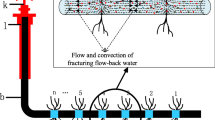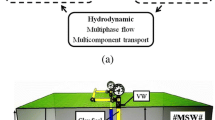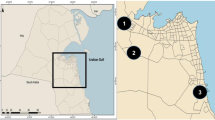Abstract
On the basis of momentum conservation and mass conservation theory, this paper proposes mathematical model to investigate recovered water flow and contaminant diffusion in the wellbore of shale gas horizontal wells. Two significant improvements are made to conventional models. One is that the quality and velocity flow of each cluster are considered as dynamic parameters in equation of flow, and another one is that source terms and reaction terms are considered as dynamic parameters in equation of contaminant diffusion. The validity of the model of recovered water flow and contaminants diffusion is verified by comparing the predicted results with the actual production data and the experimental data in the literature. Then main factors affecting the concentration of contaminants in horizontal wells are studied systematically. It can be shown that the concentration of contaminants at wellhead increases linearly with the linear increase of the initial concentration, boundary concentration and the source term in the whole time period. The concentration of contaminants increases nonlinearly with the linear increase of the length of horizontal wellbore and flow-back average velocity of recovered water in different time periods. The research of this paper provides guidance for the control of recovered water.











Similar content being viewed by others
References
Bellman R, Kalaba RE, Lockett JA (1966) Numerical inversion of the laplace transform: applications to biology, economics, engineering and physics. American Elsevier, New York
Bernardi C, Yakoubi D (2016) Spectral discretization of a model for organic pollution in waters. Math Methods Appl Sci 39(18):5192–5202
Caporina M, Fontinib F (2017) The long-run oil-natural gas price relationship and the shale gas revolution. Energy Econ 64:511–519
Chen ZR, Wang HJ, Liu QZ, Cai WH (2013) Engineering fluid mechanics. Higher education press, Beijing
Crump KS (1976) Numerical inversion of laplace transforms using a Fourier series approximation. J Assoc Comput Mach 23(1):89–96
Dai Y, Ma X, Jia A et al (2016) Pressure transient analysis of multistage fracturing horizontal wells with finite fracture conductivity in shale gas reservoirs. Environ Earth Sci 75(11):940
Estrada JM, Bhamidimarri R (2016) A review of the issues and treatment options for wastewater from shale gas extraction by hydraulic fracturing. Fuel 182:292–303
Fakcharoenphol P, Torcuk M, Kazemi H et al (2016) Effect of shut-in time on gas flow rate in hydraulic fractured shale reservoirs. J Nat Gas Sci Eng 32:109–121
Gaver DP (1966) Observing stochastic processes and approximate transform inversion. Op Res 14(3):444–459
Gorder RAV, Vajravelu K (2011) Nonlinear dispersion of a pollutant ejected into a channel flow. Cent Eur J Phys 9(5):1182–1194
Gu D, Ding D, Gao Z et al (2017) Pressure transient analysis of multiple fractured horizontal wells in naturally fractured unconventional reservoirs based on fractal theory and fractional calculus. Petroleum 3(3):326–339
Guo J, Zhang L, Zhu Q (2015) A quadruple-porosity model for transient production analysis of multiple-fractured horizontal wells in shale gas reservoirs. Environ Earth Sci 73(10):5917–5931
Jiang T, Bian X, Wang H et al (2013) Flow back mechanism study of multi-stage fracturing of shale gas horizontal wells. Pet Drill Tech 41(5):21–25
Konga FX, Chen JF, Wang HM, Liu XN, Wang XM, Wen X, Chen CM, Xie YF (2017) Application of coagulation-UF hybrid process for shale gas fracturing flowback water recycling: performance and fouling analysis. J Membr Sci 524:460–469
Li ZF, Xu HF, Zhang CY (2016) Liquid nitrogen gasification fracturing technology for shale gas development. J Petrol Sci Eng 138:253–256
Liu BJ, Shi HX, Cai YS (2012) The coupling model of wellbore conduit flow, throttled flow and formation seepage in water injection wells. Adv Ind Civil Eng 594–597:2486–2489
Liu NZ, Liu M, Zhang SC (2015) Flowback patterns of fractured shale gas wells. Nat Gas Ind 2:247–251
Liu QG, Chen YD, Wang WH, Liu H, Hu XH, Xie YX (2017) A productivity prediction model for multiple fractured horizontal wells in shale gas reservoirs. J Nat Gas Sci Eng 42:251–261
Liu ZB, Dong XX, Min C (2018) Transient analysis of contaminant diffusion in the wellbore of shale gas horizontal wells. Water Air Soil Pollut 229(7):221
Ma ZW, Pi GL, Dong XC, Chen C (2017) The situation analysis of shale gas development in China-based on structural equation modeling. Renew Sustain Energy Rev 67:1300–1307
Majumder P, Eldho TI (2017) Vectorized simulation of groundwater flow and contaminant transport using analytic element method and random walk particle tracking. Hydrol Process 31(5):1144–1160
Makinde OD, Chinyoka T (2010) Transient analysis of pollutant dispersion in a cylindrical pipe with a nonlinear waste discharge concentration. Comput Math Appl 60(3):642–652
Middleton RS, Gupta R, Hyman JD, Viswanathan HS (2017) The shale gas revolution: barriers, sustainability, and emerging opportunities. Appl Energy 199:88–95
Moitsheki RJ, Makinde OD (2009) Symmetry reductions and solutions for contaminant diffusion in a cylindrical system. Nonlinear Anal Real World Appl 10(6):3420–3427
Panagoulia D, Tsekouras GJ, Kousiouris G (2017) A multi-stage methodology for selecting input variables in ANN forecasting of river flows. Glob NEST J 19(1):49–57
Park I, Seo IW, Kim YD et al (2016) Flow and dispersion analysis of shallow water problems with Froude number variation. Environ Earth Sci 75(2):1–12
Sharak AZ, Noel M, Dehghanpour H (2014) Understanding the origin of flowback salts: a laboratory and field study. In: Paper SPE 171647 presented at the Society of Petroleum Engineers Held in Calgary, Alberta, Canada, 30 September–2 October
Stehfest H (1970) Remark on algorithm 368: numerical inversion of Laplace transforms. Commun ACM 13(10):624
Wang F, Pan ZP, Zhang SC (2016) Modeling fracturing-fluid flowback behavior in hydraulically fractured shale gas under chemical potential dominated conditions. Appl Geochem 74:194–202
Wang F, Pan Z, Zhang S (2017) Impact of chemical osmosis on water leakoff and flowback behavior from hydraulically fractured gas shale. J Petrol Sci Eng 151:264–274
Xu ZG (2012) Remediation and transport modeling of organic contamination and heavy metal in groundwater. Shanghai Jiao Tong University, Shanghai
Zolfaghari A, Dehghanpour H, Bearinger D (2016) Fracture characterization using flowback salt-concentration transient. SPE 168598 J 21(01):233–244
Acknowledgements
The work is supported by National Science Fund-Tianyuan Mathematical Fund (Nos. 11601451, 11526173) and applied fundamental research (Major frontier projects) of Sichuan Province (No. 16JC0314).
Author information
Authors and Affiliations
Corresponding author
Ethics declarations
Conflict of interest
The authors declare that there is no conflict of interest regarding the publication of this paper.
Additional information
Publisher's Note
Springer Nature remains neutral with regard to jurisdictional claims in published maps and institutional affiliations.
This article is a part of a Topical Collection in Environmental Earth Sciences on Water Resources and Hydraulic Engineering, guest edited by Drs. Yanqing Lian, Walton Kelly, and Fulin Li.
Rights and permissions
About this article
Cite this article
Liu, Z., Dong, X., Chen, L. et al. Numerical simulation of recovered water flow and contaminants diffusion in the wellbore of shale gas horizontal wells. Environ Earth Sci 79, 128 (2020). https://doi.org/10.1007/s12665-020-8866-z
Received:
Accepted:
Published:
DOI: https://doi.org/10.1007/s12665-020-8866-z




